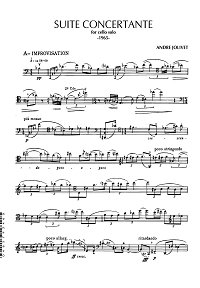Jolivet - Concert suite for cello solo (1965)
Jolivet - Concert suite for cello solo (1965). You can download the PDF sheet music Jolivet - Concert suite for cello solo (1965) on this page. André Jolivet's Suite en concert (1965) has, like Bach's Cello Suites, a contemporary violin pendant, the Suite rhapsodique, also in five movements. Jolivet's Cello Suite is however not a collection of dance movements in the usual sense.
To download PDF, click the "Download PDF" button below the appropriate sheet music image.
To view the first page of Jolivet - Concert suite for cello solo (1965) click the music sheet image. |
| PDF format sheet music |
|
|
|
Cello part: 11 pages. 2194 K
|
|
 |
|
|
|
| Download PDF (14.99
€) |
|
|
In the place of the Prelude, which served originally as a'warm-up' for the player, and was, before Bach, improvised by him, Jolivet writes an Improvisation. In it are to be found the main ideas of the Suite. Like a breath of air, the arpeggiando, a gesture which characterizes the whole piece, sets up an atmosphere which creates its effect through its vague rhythm and the complete absence of pure intervals. This metaphor of seeking, or inspiration, is the theme of the movement. Out of it arises a first melody, which returns in the closing movement and—after the appearance of pure intervals—a second melody which becomes the theme of the middle movement. Glissandi disappearing into the heights and falling into the depths occur again in the second and fourth movement, and the end of the Improvisation also provides a model for the succeeding movements: the characteristic intervals of a tritone and a seventh are directly opposed to the pure fifths and fourths, as it were in a test of strength.
The theme of the Ballade is a retreat into the self, following a nervous introduction. After renewed, increasingly wild agitation it is a scream of discontent in which the original interval of a second is torn apart into sevenths and ninths. Someone is humming the melody in Air to himself, and his thoughts are lost in the arpeggios.The Sérénade is marked Fantasque et désinvolte—cranky and casual. The most delicate moment in the midst of electrifying rhythms and boisterous articulations is the way the wave of fifths from the second part of the Improvisation suddenly pours forth.
After these four movements that do not conform to any type—in the choice of titles there is a stress on the vocal—-Joiivet chooses for the conclusion of his Suite that other genre in which multi-movement works have been cast since the baroque and which ranks as the essence of classical form—a Sonata. It appears here as in the late 19th century in the 'compact version' in which its distinctive features (first movement sonata form and a slow central movement) are united in a single movement.
There are two themes, one syncopated and catapulted upwards from out of a tense chord and a second which persists in its narrow tonal range—as opposed to the syncopations of the main theme it moves with sharp and closely circumscribed, pointed rhythms. In the recapitulation they appear immediately after one another, closer in pitch and breadth. The ever-repeated semiquaver passage, which plays with sevenths and ninths, and later with sixths, fifths and the second theme, is a variant of the 'wave of fifths' from the Improvisation and the 'clash of intervals' of its conclusion. On the very last beat the pure fifths and fourths emerge triumphantly victorious.
|
|